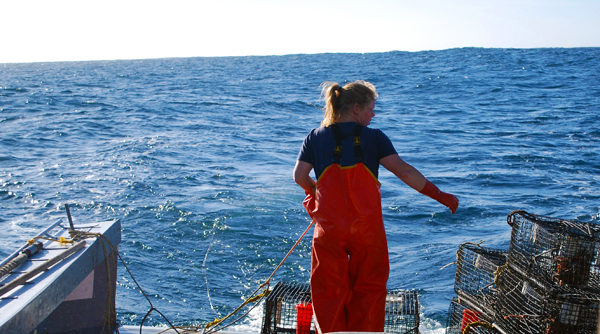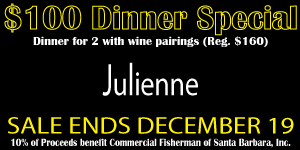
Stephanie Mutz, President of the Commercial Fisherman of Santa Barbara organization, out in the Santa Barbara Channel while fishing for crab.
Imagine if great white sharks were a hazard at your job. It’s a strange but true reality for many commercial fishermen working out of the Santa Barbara harbor.
It’s because sea urchin, the source of the Japanese delicacy uni, can only be harvested by divers and the Channel Islands happen to be one of the top fishing grounds in the world for the spiny creatures.
The community of some 200 fishermen working from Santa Barbara also provides halibut, crab, white sea bass, cod, swordfish and spiny lobster to name a few.
It’s something that the restaurant Julienne appreciates, and that’s why they’ve chosen to donate 10% of the proceeds from a December special they’re running with CentralCoastDining.com to the non-profit Commercial Fishermen of Santa Barbara (CFSB).
“Between the fishermen and the farmer’s market, in terms of freshness and quality goes, it’s paramount,” said Julienne chef Justin West. “It’s why the food tastes so good here without a doubt.”
Besides supporting local business, CFSB President Stephanie Mutz says the local catch is fresher and can be cheaper than similar product found in markets.?The drawbacks are that the supply can be inconsistent because the boats can’t go out in poor weather and variety is limited depending on the time of year.
The CFSB supports the small-boat operators that don’t have the time on their own to market themselves or stay on top of the paperwork that goes with conforming to the increasing number of regulations. It also invests money in communal equipment needed to improve operations in the harbor.
“We are all competing against each other, but we’re all united too. We are all in it together. It’s what CFSB is all about,” Mutz said.
The Fisherman’s Market on Saturday mornings is an example of the collaboration, providing an opportunity for local fisherman to connect directly with local consumers. While much of their catch is shipped out of town, as much of the fresh seafood as possible is kept local.
Harry Liquornik, a 28-year veteran and past president of CFSB, says keeping his catch local is more rewarding than sending it elsewhere. Uni, once predominantly consumed in Japan, has become much more common to find on local menus.
CFSB monitors these consumption trends and works to make sure local fishermen can continue to make a living in a fiercely competitive business.?The organization was formed in 1971, soon after the 1969 oil spill suspended fishing operations locally and the need for cooperation became necessary to protect their interests.
“It started to make fishing easier for commercial fisherman,” Liquornik said.
On top of all these challenges, the famous white shark lurks. ?Just about every long-time urchin diver has a white-shark encounter to talk about. Just this week, the urchin diving community gathered at Brophy’s on the anniversary of Jim Robinson’s death in 1994 from a shark attack. That’s the last urchin diver fatality out of Santa Barbara.
“We drink Tequila and tip one over for Jim Robinson and tip one over for the ‘Landlord’ too, ?out of respect,” Mutz said.
It’s all a part of the job, however.
“You gotta love it or you aren’t going to last long,” Liquornik said.
Reports on what’s available week to week at the fishermen’s market can be found on Twitter.
Sea urchin. Rockfish. Rock crab and claws. Lingcod. Spiny lobster. Whelks. At Fisherman Market on pier outside @brophys 6am tomorrow
? CFSB (@cfsbinc) November 23, 2013

